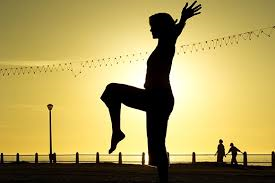
By: Cheryl Mitchell, IFTA Certified Group Fitness Instructor
February 2017
One of the main changes our bodies experience as we age is loss of muscle mass. Over the past few years, the medical and health & fitness community remind us from time to time that if we stay active by performing strength training exercises with regularity (3 to 4 times a week for at least 20 minutes at a moderate level is usually recommended), we can counteract some of that muscle loss.
Well did you know that as we age, our balance diminishes as well ? “Ever so gradually after we hit [age] 30, muscles we use to stand tall weaken. The length of our stride shortens, the pace of our steps slows, and vision-critical to coordination [and balance] becomes fuzzier (www.prevention.com).”
Sway envelope:
How far a person is able to lean in any direction without having to take a step in that direction constitutes their stability limits or something called “sway envelope.” This sway envelope is often much smaller in older adults who have begun to experience balance problems. As the distance in the sway envelope decreases, the chance of losing one’s balance and falling increases.
As we age, it becomes more critical that we maintain good balance. A publication on Older Adult Fitness by the American Adult Assoc. International states, “Falls are the second leading cause of accidental death in the United States. Seventy-five percent of these falls occur in the older adult population. One third of the older adults who fall, sustain a hip fracture and are hospitalized.”
Consider the following facts from an article entitled, “Falls: How big is the Problem:”
- Falls are the leading cause of a move to skilled-care facilities, often long term.
- 20-30% of those who fall suffer moderate to severe physical injuries including breaks, cuts, and bruising.
- Falls often result in long-term pain.
- Falls involving a hip fracture lead to 10-15% reduction in life expectancy.
- Older adults who fall are likely to worry about the future and loss of independence.
- Loss of self-esteem and mobility leads to decreased activity and eventually inability to perform activities of daily living.
- Because of decreased confidence and physical functioning, patients who fall are likely to fall again.
- Older adults are less likely to take part in beneficial activities like exercising or socializing because of a fear of getting hurt again and the embarrassment of a fall.
What can we do to improve our balance and decrease our chances of falls ?
Balance exercises along with certain strength exercises can help improve balance stability and prevent falls. Balance exercises improves one’s ability to control and maintain the body’s position whether moving or standing still.
Balance Exercises to Try:
There are exercises that are specifically aimed at improving your balance and lower body strength. For your convenience, I have provided the links for two videos posted on youtube.com. Click on the links below.
For beginners, I recommend the exercises in the first video with physical therapist and Doctor of physical therapy, Doctor Jo. These exercises strengthen the ankles and improve balance.
For intermediate to advanced, I recommend executing the exercises in the second video with the exercise A.C.E. (American Council on Exercise) certified physiologist, Fabeo Comana.
https://www.youtube.com/watch?v=Nc62Ju2kUAc
https://www.youtube.com/watch?v=AWuKEt96Jjs
Each video demonstrates the moves with the correct form and provides alternatives depending on your level. Make sure you can successfully execute the beginner moves shown before trying the advanced versions. If you are a novice, initially perform the moves holding with both hands on a chair or countertop. With practice, you will be able to execute the moves holding on with one hand and eventually without the assistance of a chair or countertop. You will find that the more you practice these moves, the easier it will become to perform them and your balance will improve. In order to preserve the progress you make, you will need to perform these moves with regularity. I suggest 3 to 4 times per week for at least 15-20 minutes.
Certain fitness classes such as tai chi and yoga are also designed to aide in increasing balance and strength. I offer a one-hour Cardiodance and Strength Training class twice a week that incorporates balance moves for all fitness levels. You are always welcome to come and participate.
Be aware that balance can be improved at any age. Take time to work on your balance and strength on a regular basis-Become the best you that you can be!
Sources: www.prevention.com, www.youtube.com, “Falls: How big is the Problem” from www.indiana.edu, and a publication from the American Adult Assoc. International on Older Adult Fitness
It is always recommended that you consult with your physician before starting any exercise program.













Great article. Very informative.
Comments are closed.